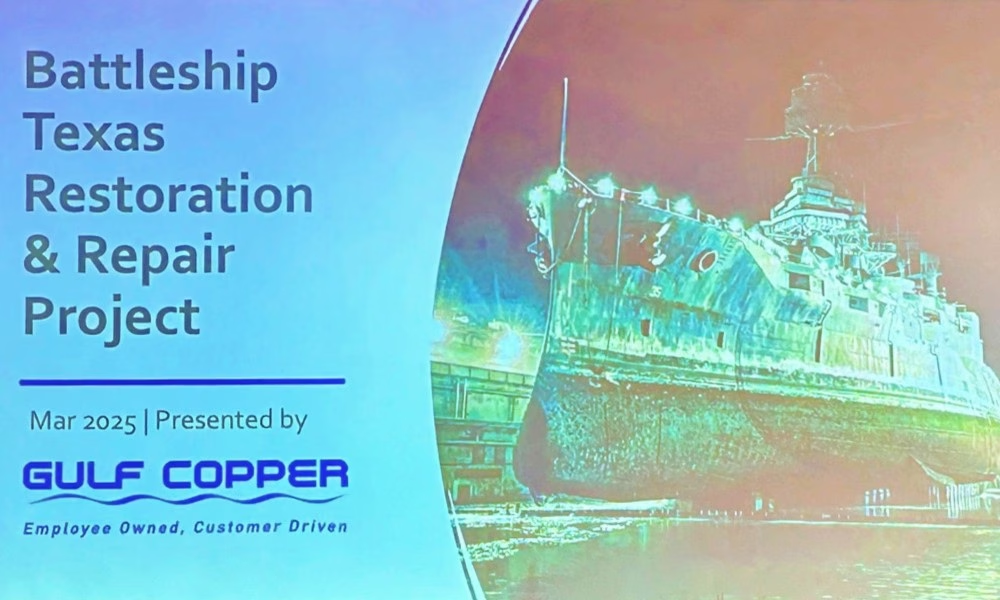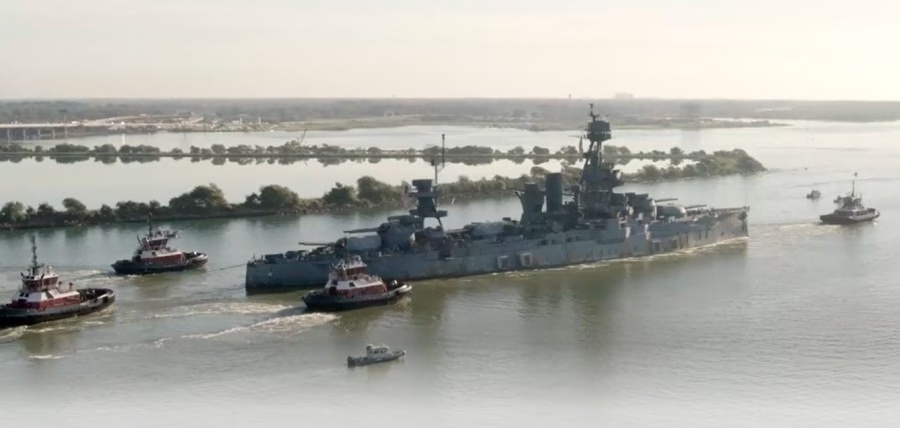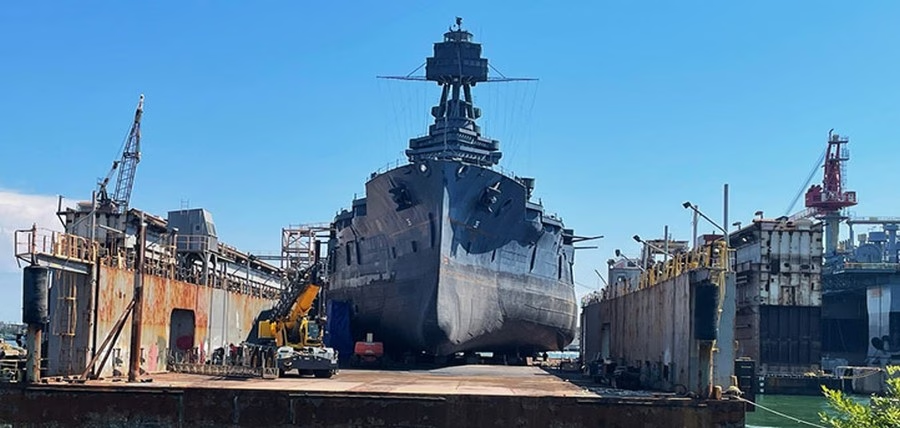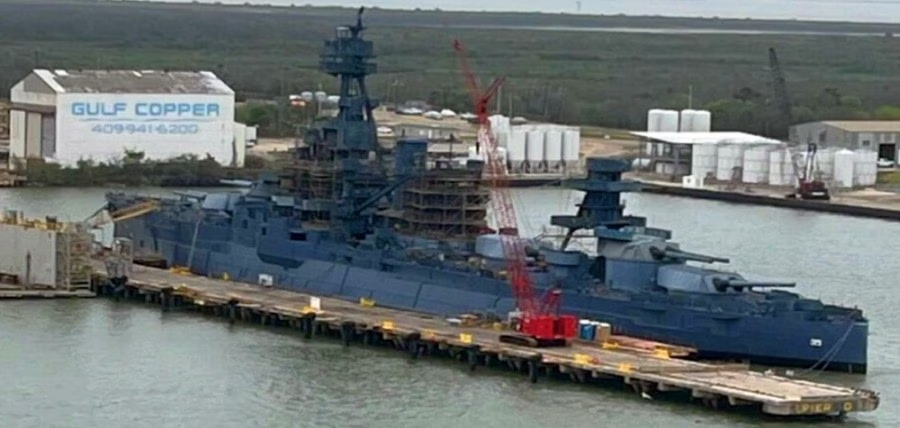
In 1914, the United States Navy commissioned a battleship that would go on to make history: the Battleship Texas. This formidable vessel saw service in both World War I and World War II, earning its place as a revered national treasure. But by the late 2010s, time, saltwater, and decades of insufficient maintenance had brought the mighty ship to the brink of irreversible decay. It was taking on thousands of gallons of water a minute, relying on over 30 pumps running around the clock just to stay afloat. The future looked grim.
Today, thanks to an unprecedented engineering and restoration effort led by Gulf Copper and the Battleship Texas Foundation, the ship is not only surviving—it’s being reborn.
This article is from an audio visual presentation by David Casale, Gulf Copper Project Manager for the Battleship Texas Restoration, on March 11 at Jose’ Cantina Restaurant in Crystal Beach.
A Ship in Crisis
By 2019, the ship’s condition was dire. The steel hull had corroded in hundreds of places, with water pouring in through holes large and small. The situation became so severe that the ship even sank slightly in its berth at San Jacinto. It was clear: without massive intervention, the Battleship Texas would be lost.
The Texas state legislature stepped in, allocating $35 million for critical restoration. But the funds came with requirements. First, the ship could no longer remain at San Jacinto—a location plagued by declining tourism and considered historically incompatible with the ship’s legacy. Second, the Battleship Texas Foundation had to find a new home that could sustain ongoing maintenance through increased visitor revenue.
A Risky Voyage
Moving the ship to Gulf Copper’s dry dock in Galveston posed a major challenge. With no propulsion system and a hull riddled with leaks, the ship couldn’t simply be towed through the busy Houston Ship Channel. The solution? Engineers filled the vessel’s internal tanks with 750,000 gallons of closed-cell foam to stabilize the structure and reduce flooding. It was a temporary fix—costly to install and equally expensive to remove—but it allowed the Coast Guard to approve the tow to Galveston.

A Herculean Restoration Begins
In August 2022, Battleship Texas was lifted out of the water for the first time since 1988 and placed onto a dry dock at Gulf Copper’s facility. The scale of the work ahead was daunting.
The primary goal was to stop the ship from leaking—a deceptively simple task that required replacing 700 tons of steel in the submerged hull alone. That area, everything below the waterline, was extensively corroded. Massive sections of steel had to be cropped out and replaced with newly fabricated parts.
Yet before any of this could happen, crews had to deal with the foam that had filled the ship’s tanks for the transit. The foam was dense, flammable, and released toxic fumes if heated. Traditional cutting torches were off the table. Instead, workers used high-pressure water jets operating at 18,000 PSI to pulverize the foam, while cold-cutting water jets created access windows in the steel. The effort removed 325 roll-off containers—each 25 cubic yards—of pulverized foam.

A Heavyweight Restoration
Restoring Battleship Texas wasn’t just labor-intensive—it was physically intense. The ship’s steel is far heavier and denser than that used on merchant ships. Its armor belt, located along the waterline, averages 7 inches thick, and the gun turrets and combat zones are fortified with steel several inches thick. While a merchant ship of similar size might weigh half as much, the battleship’s heavy-duty steel and warfighting systems make it a steel behemoth.
As of early 2025, over 350,000 man-hours have been invested in the project, with more still ahead.

Topside Repairs: Guns, Towers, and Superstructure
Beyond the hull, extensive topside work has transformed the ship’s appearance and function. One major priority was restoring the ship’s iconic five-inch guns. Each gun, weighing 26,000 pounds, was removed and sent to a donated warehouse for restoration. Meanwhile, the gun foundations—made of steel and heavy timber—were rebuilt to securely support the massive weapons.
New bolts, wood layers, and structural steel were installed before the guns were carefully re-mounted—a rigging challenge due to narrow access points and tight spaces.
Similar repairs were conducted across the ship’s superstructure. The forward and aft fire control towers, both structurally compromised, required scaffolding, internal repairs, and restoration. The top of the forward tower was even cut off and lowered to the ground for more efficient repairs before being returned to the ship.
Drainage systems, vent pipes, and smokestacks were rebuilt, replacing decades-old systems that had allowed rainwater to seep into the interior spaces, contributing to widespread damage.
Fixing the Past: Undoing Improper Repairs
One of the most surprising challenges was undoing poorly executed repairs from previous decades. In the 1970s and 1980s, many areas were sealed or patched incorrectly—sometimes in ways that violated historical authenticity. In some cases, built-in WWII-era furniture was removed and scrapped simply to access flooring. In others, control towers were sealed off with sheets of steel, masking original features like windows and viewing turrets.
Now, the restoration team is committed to both structural soundness and historical accuracy. Where possible, they are restoring these features to their original form, guided by photographs, physical evidence, and even hand-drawn sketches—since original ship plans are not available in digital formats.
A Deck Reborn
Another major focus of the restoration is the wooden deck. Originally made of southern yellow pine, not teak as some believe, the existing deck was installed in 1988 and had since rotted beyond repair due to neglect and exposure.
The new deck, also southern yellow pine, is being rebuilt section by section. Each plank is custom-cut to fit around the ship’s intricate curves, fittings, gun tubs, and ventilation shafts. Beneath the wood, corroded steel deck plates are being replaced and resealed.
Installing the deck is a labor-intensive process. Each of the 31,000 metal studs securing the wood to the steel deck must be precisely placed, and each wooden plank is sealed with cotton roping, oakum (hemp) and pitch in a traditional caulking method to protect against moisture.
Interior Work and Future Accessibility
The next phase of restoration includes the ship’s interior spaces—crew quarters, mess areas, and compartments below deck that have also suffered from water intrusion and age. The goal is to open more of the ship to public access while addressing modern safety standards. Some vertical ladders may be modified for safer access, and walkthrough experiences will be designed to showcase engineering marvels like the engine and boiler rooms.
While the ship’s original propulsion systems remain in place, the propellers and shafts were removed during decommissioning. Visitors will still be able to see much of the original machinery, even though it’s no longer operational.
A New Home in Galveston
After years of uncertainty, the Battleship Texas now has a confirmed future home: Pier 15 in Galveston, nestled between cruise terminals for MSC, Norwegian, and Royal Caribbean. The location promises a dramatic increase in foot traffic, visibility, and tourism revenue.
Adjacent facilities are expected to house the ship’s museum and visitor center. As of now, the restoration and relocation costs are estimated at $75 million, including ship repairs, museum buildout, interpretive displays, and curation of historical artifacts.
Of that, approximately $60 million has been provided by the State of Texas, with the remaining $15 million raised through donations and private support.
A Triumph of Engineering and Preservation
Restoring Battleship Texas has required more than materials and labor—it’s demanded problem-solving, craftsmanship, and respect for history. From cutting steel with precision, to recreating lost architectural features by hand, this project is equal parts engineering feat and cultural resurrection.
Casale stated, “It has truly been a partnership between the Battleship Texas Foundation and Gulf Copper. Their personnel have been here every single day and Gulf Copper could not have figured out all the historical and technical requirements alone.”
Though the ship was once dangerously close to being lost to time and tide, it is now on course for a second life—one that will educate, inspire, and honor the generations of sailors who once served aboard.
And thanks to the immense work of the Battleship Texas Foundation and Gulf Copper team, the Battleship Texas will continue to stand not just as a monument of war, but as a testament to the power of preservation, ingenuity, and the enduring legacy of American craftsmanship.





Gary Hunstiger
March 18, 2025 at 7:45 pmCongratulations; the juice is worth the squeeze to restore the Battleship Texas for the generations to come and understand her proud Navy history!!